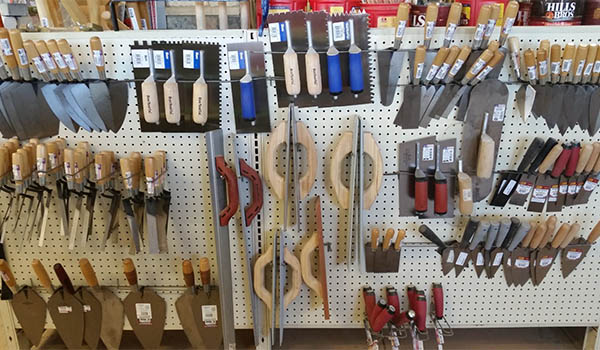Hand floats can be assembled from three materials, wood, magnesium, or aluminium and can have either wooden or rubber handles. Trowels are made of steel and come in either stiffer steel typically known as blue steel which is firmer, or a thinner steel used in “Pool” trowels. Trowels also can be assembled with either wooden or rubber handles.
Based on the concrete project you are taking on, for starters, you need to choose your hand float based on two criteria: whether you are placing inside slabs or outside flatwork. When it comes to floating off the top of a foundation, the material of your float is inconsequential.
If you are placing outside flatwork or curbs, you might be interested to learn that traditionally wooden floats and darbys have helped prevent spalling and have been the go-to floats for many years. There is no rule against using a magnesium or aluminum float on outside flatwork, but the porous nature of the wooden float helps prevent trapping moisture within a slab.
When it comes to placing an inside slab, magnesium floats are the best choice. Aluminum floats mimic the property of being able to help seal the surface of the concrete slab like a magnesium float can, but they simply do not have the durability that magnesium floats provide. A wooden float would be a poor choice to use on an inside slab, though many tradesmen have used wooden bullfoats on inside slabs before the introduction of magnesium bullfoats.
When it comes to selecting a steel trowel, there are a few criteria to consider. For placing outside slabs, some building codes forbid the use of steel trowels or the use of fresnos. The reasoning behind this is that steel tools close in the cement so well, moisture that is absorbed into the concrete can become trapped and will eventually cause the aggregated within the slab to expand during freeze/thaw cycles causing the top layer of the slab to pop off.
When it comes to placing inside slabs, it is uncommon to use a pool trowel. Pool towels are made of a much more flexible steel and gain their title “pool trowel” because of their use in swimming pool construction. Pool trowels are rounded at both ends and are very flexible which therefore allow the concrete finisher to cover small imperfections in the concrete slab while at the same time simultaneously sealing the surface of the cement.
When a tradesman is finishing an inside slab, the first consideration in selecting a trowel follows the consistency of how hard the initial slab has become. So for example, the first time that a finisher begins to trowel the slab, the finisher will do best to use a trowel that is longer in length, for example typically 18 to 20 inches, and the trowel having a width of around 4 inches. The reason for the length and the width needing to be longer and wider initially, are due to the consistency of the surface of the concrete. For example as the concrete begins to harden enough to support the weight of a concrete finisher, it is much more pliable and softer at first and requires a greater span of troweling material. Therefore, as the concrete begins to get harder, the length of the trial can be shorter and also needs to be shorter. Many slabs are troweled three of four times by hand before the slab is completed. With each sequential pass over the entire slab, the concrete finisher will need a shorter trowel to accommodate the tightening cement.
The final consideration in selecting a float or trowel is the material of the handle. There are two main materials, wood or rubber. Some manufactures do make hand floats with hard plastic handles, though these are not very common. Why would you want a wood handle or a rubber handle? The choice narrows down to comfort for most tradesmen. The rubber handles are designed to to feel more comfortable as the tradesman leans their weight onto their hands. If the rubber handles are more comfortable, why would there still be a demand for floats and trowels with wooden handles…? For many tradesmen, the rubber handles become too slippery as they sweat, but with the wooden handles, your sweat actually helps you grip the handle better.
There are many options when it comes to selecting floats and trowels, and Barnsco is proud to offer as many choices as possible. The next time you are looking for a float or trowel, check out our extensive inventory of Hand Tools.

